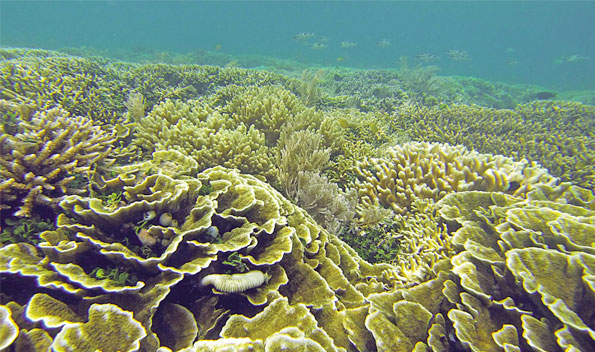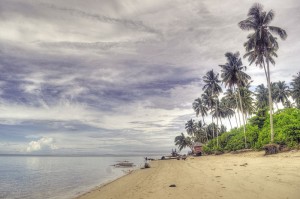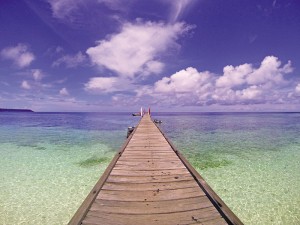“Perhaps life is just that… a dream and a fear.” – Conrad
And so another sojourn in the far-flung archipelago of Indonesia; this time to the Derawan islands off the northeast coast of Kalimantan – the name for Indonesia’s part of Borneo, the third largest island in the world and the largest in Asia.
I’d never been to Borneo before, and so it was with much excitement that we arose at the ungodly hour of 3am – a calculated move, mind you, to avoid Jakarta’s soul-crushing traffic jams on the way to the airport, a huge problem at many other times of the day, which often results in people missing their flights.
Our first flight brought us as far as Balikpapan, and from there we took a connecting flight to Berau, or more accurately Tanjung Redeb, the town that Conrad based his imaginary village Sambir in his books Almayer’s Folly and an Outcast of the Islands.
Yet despite its associations with classic literature, Tanjung Redeb is not as beguiling as it sounds; in fact, it’s as nondescript as a plain cardboard box, a more unattractive place in Indonesia you will struggle to find, succinctly summed up by Conrad’s fictional character Almayer as “that god forsaken hole”.
Back in Conrad’s day, Tanjung Redeb – which is situated on the banks of the huge Mahakam River – was a trading post for goods from the interior; bird nests, gutta percha, rattan, that sort of thing. Occasionally, indigenous tribesman from the interior would make their way up the river – these are the Dayak, famed headhunters and cannibals (at least they were), notable for their elongated earlobes and tribal tattoos.
But times change and what you get floating up the river in 2013 is felled timber and humungous-sized barges of coal, much of which is sourced from the vast Berau Coal open mine coal pits (in 2012, production reached around 21 million tons), partly owned (indirectly) by Aburizal Bakrie, the Golkar Party chairman and aspiring 2014 presidential candidate.
To get to the small port on the coast from Tanjung Redeb takes about two hours by car. You can look out the window and witness for yourself the ongoing destruction and mutilation of Kalimantan’s once pristine jungles or you can keep your eyes closed. I’d recommend the latter – it’s less painful.
From the small port called Tanjung Batu, it’s a 40 minute ride in a speed boat to Derawan – easily the most fun part of the journey.
 Derawan Island
Derawan Island
Derawan is a small island that you can walk around in 30 minutes or so and is famed for its turtles, which are easy to see whether diving or snorkelling, or even from one of the island’s jetties which stretch out into the open sea. Derawan is also the most practical place to base yourself while in the area; the accommodations are cheap (no overpriced luxury dive resorts here), there are plenty of simple restaurants to eat at, and you can also organize diving and boat trips to the other islands – of which there are 31 in total. There is a population of around 800 hardy souls living on Derawan, many of whom are the famed bajau (sea gypsies) who can trace their ancestry to the Philippines where they once lived a nomadic lifestyle.
So is it paradise? Well yes, and no. From a positive aspect, the turtles are truly magnificent and the island’s relative remoteness means that Derawan still retains that “Robinson Crusoe” idyllic island charm. But this may not last.
Unfortunately, the locals don’t care much for turtles and will steal their eggs if they can (the WWF had to initiate a conservation program to prevent turtle eggs from being stolen after they have been laid). On top of that, the locals also consider their beautiful island to be some sort of a huge rubbish tip and dispose of garbage anywhere and everywhere; on land or into the sea – it doesn’t really matter as they don’t seem to care. As for your long sought-after tranquillity? Well, you should definitely get it on the weekdays. But come on the weekend and be prepared to have your peace shattered by groups of noisy, local tourists who descend upon the island in droves.
To reach the other islands near Derawan you have to charter speedboats. Obviously the more people there are, the cheaper it works out.
Kakaban
This incredible island feels like something out of Jurassic Park and has a pristine coral reef to snorkel or dive, but is best known for its salt water lake which is populated by a huge number of non-stinging jellyfish – making it a truly amazing and unique place to snorkel.
Sangalaki
Sangalaki is best known for its mantas, although in a rather ominous development, they are becoming much more difficult to spot, possibly frightened away by fishermen or for other reasons.
Maratua
Home to at least three luxury dive resorts, Maratua is the most populated island with c. 3,000 inhabitants. Despite the crystal clear waters, however, I was astonished by the large amount of floating trash – especially plastic bags and empty bottles, directly in front of one of the dive resorts. I was assured by one of the resorts staff that this was “natural” rubbish and had nothing to do with the people living on the island. Hmm…
 Traveller Tips
Traveller Tips
- One of the best places to stay on the island is called the Reza and Dira Homestay. The rooms are newly built and situated above the sea by a wooden jetty. The rooms are clean with decent beds and aircon, which, be warned, doesn’t work when there are many guests as the power supply is not large enough! Breakfast is very simple (bread) but you do get a flask of hot water to make coffee and tea. The price per night as of July 2013 is a very reasonable Rp.250k.
- To get to Derawan you need to fly to Berau. From there you need land transportation to Tanjung Batu and then a speedboat to Derawan. It’s best to arrange this in advance. If you stay at Reza’s, they will handle it for you (the return trip Berau- Derawan will cost Rp.1.4 million for three people). The contact man at Reza’s is Darjohn (he can be reached by phone at +62 81347955950).
- Besides organizing transportation (including boat trips to the other islands) Darjohn is also involved in the WWF’s program to protect turtles. If it’s the right time of the year, turtles come on shore to lay eggs (usually between 8-10pm). And if you are lucky, you may be able to see this yourself. Ask Darjohn.
- Diving can easily be organized on the island (for example at the rather rundown Darakan Losmen). A new dive place in the village has also just opened. Make sure, however, that you are clear over prices or they may overcharge. Also check that the dive equipment is okay and that the dive instructor is competent; it’s an awful long way to the nearest decompression chamber (just ask Angela).
- There are a lot of bad restaurants on Derawan. By far the best one is called Restaurant Nur. It is run by a droll middle-aged woman who is honest and an excellent cook. Her fish, squid and shrimps are always fresh. Just be prepared to wait a while for her to fix your meal!
- Apart from the seafood and not much else, everything has to be transported from Berau – and so tends to be fairly pricey or unavailable. For this reason, bring plenty of snacks, and if you think you might need it, a bottle or two of booze.
- Getting to Derawan is pretty expensive and time consuming, so don’t just come for a few days but stay at least a week.
- If you need to be connected to the outside world make sure you have either a Telkom or XL SIM card. Other operators do not work here.
- Bring some reading material. Almayer’s Folly: A Story of an Eastern River by Joseph Conrad is in the public domain and can be downloaded for free at Gutenberg.






